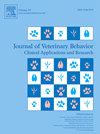医院环境中诱狗信息素对心血管的影响
IF 1.3
3区 农林科学
Q4 BEHAVIORAL SCIENCES
Journal of Veterinary Behavior-clinical Applications and Research
Pub Date : 2024-08-14
DOI:10.1016/j.jveb.2024.08.003
引用次数: 0
摘要
最近的研究强调了急性或慢性压力对动物健康的影响。由于各种因素,包括接触新环境、侵入性程序以及与主要照料者分离,住院的狗很容易受到压力的影响。压力对这些动物的临床意义强调了从入院开始就进行压力管理的重要性。然而,目前仍缺乏通用的小动物应激定性和定量指标,因此必须依靠行为分析和应激标记物评估来进行准确诊断。在这些指标中,心率和收缩压等心血管参数是常用指标,但其解释可能会受到各种因素的影响。本研究旨在评估绥靖信息素对住院犬心血管参数的影响。研究选取了 10 只健康犬进行前瞻性、配对、随机和双盲试验。这些狗接受了两种实验方案:信息素给药和安慰剂给药。从基线到 24 小时住院期结束,对心血管参数进行了评估。研究评估了动态心电图和使用多普勒的收缩期无创血压。对心血管参数的分析表明,尽管收缩压在两种治疗条件下均有所升高,但各组之间并无明显差异。在安慰剂组中,安慰剂组在基线时间(T0)的最大心率低于随后的时间点(T6、T12、T20),这表明在到达医院环境时存在压力。相反,费洛蒙组在 T20 时的平均心率高于安慰剂组。此外,与后面的时间点(T6、T12、T20、T24)相比,安慰剂组在基线时间(T0)显示出更高的最低心率。在 T6 时间点,费洛蒙组的最低心率更高。尽管在监测过程中观察到平均心率和最低心率有波动,但这些波动并没有显示出与临床相关的偏差。不同分析物质的心率变异性在时间上没有差异。因此,通过扩散器展示的方式接触诱狗信息素并不会导致住院狗狗在减压方面的心血管参数发生显著变化。本文章由计算机程序翻译,如有差异,请以英文原文为准。
Cardiovascular effects of dog-appeasing pheromone in the hospital environment
Recent research has emphasized the health implications of acute or chronic stress in animals. Hospitalized dogs are susceptible to stress due to various factors, including exposure to a novel environment, invasive procedures, and separation from their primary caregiver. The clinical significance of stress in these animals underscores the importance of stress management from the moment of admission. However, there remains a lack of universal qualitative and quantitative indicators of stress in small animals, necessitating reliance on behavioral analysis and stress marker assessment for accurate diagnosis. Among these markers, cardiovascular parameters such as heart rate and systolic blood pressure are commonly used, although their interpretation can be influenced by various factors. The aim of the study was to assess the impact of appeasing pheromone on cardiovascular parameters in hospitalized dogs. Ten healthy dogs were selected for a prospective, paired, randomized, and double-blinded. The dogs were submitted to two experimental protocols: pheromone administration and placebo. The cardiovascular parameters were evaluated at baseline until the end of a 24-hour hospitalization period. The study evaluated ambulatory electrocardiography and systolic noninvasive blood pressure using a Doppler. Analysis of cardiovascular parameters revealed no significant difference in systolic blood pressure between groups, despite its elevation in both treatment conditions. In the placebo group, the maximum heart rate of the placebo group at the time baseline (T0) was lower compared to subsequent time points (T6, T12, T20), indicative of stress upon arrival in the hospital environment. Conversely, the pheromone group showed a higher mean heart rate at T20 compared to the placebo group. Additionally, the placebo group displayed a higher minimum heart rate at time baseline (T0) compared to later time points (T6, T12, T20, T24). At time T6, a higher minimum heart rate was observed in the pheromone group. Even though fluctuations were observed in mean and minimum heart rates during monitoring, they indicated no clinically relevant deviations. There was no difference in heart rate variability over time between the analyzed substances. Exposure to dog-appeasing pheromone through a diffuser presentation, therefore, did not lead to significant changes in cardiovascular parameters related to stress reduction in hospitalized dogs.
求助全文
通过发布文献求助,成功后即可免费获取论文全文。
去求助
来源期刊
CiteScore
3.50
自引率
16.70%
发文量
107
审稿时长
325 days
期刊介绍:
Journal of Veterinary Behavior: Clinical Applications and Research is an international journal that focuses on all aspects of veterinary behavioral medicine, with a particular emphasis on clinical applications and research. Articles cover such topics as basic research involving normal signaling or social behaviors, welfare and/or housing issues, molecular or quantitative genetics, and applied behavioral issues (eg, working dogs) that may have implications for clinical interest or assessment.
JVEB is the official journal of the Australian Veterinary Behaviour Interest Group, the British Veterinary Behaviour Association, Gesellschaft fr Tierverhaltensmedizin und Therapie, the International Working Dog Breeding Association, the Pet Professional Guild, the Association Veterinaire Suisse pour la Medecine Comportementale, and The American Veterinary Society of Animal Behavior.

 求助内容:
求助内容: 应助结果提醒方式:
应助结果提醒方式:


